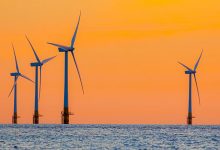New research has found that the cost of offshore wind farms in some parts of the world is now so low, that they are generating ‘negative subsidies’ that leave energy users financially better off.
The new assessment of offshore wind power costs has been published in the academic journal Nature Energy, and was led by researchers from the Centre for Environmental Policy at the Imperial College London.
The researchers analysed the results from a range of renewable energy support schemes used by different European countries, where auctions are generally designed to provide a revenue guarantee to new wind and solar projects, while also identifying the most commercially competitive projects.
Under the renewable energy support schemes, the successful projects are offered a ‘contract for difference’ agreement, which sets a guaranteed price to be paid for the electricity generated from wind and solar projects.
The analysis also found that the cost of offshore wind farms had fallen dramatically since 2015, with projects successfully achieving continued cuts to technology costs while improvements in larger and higher performance wind turbines have allowed projects to improve their operating efficiency.
The researchers found that costs of offshore wind projects had fallen to such an extent that the projects were able to agree to prices fixed under the ‘contract for difference’ agreements that were less than what could be earnt by the projects in wholesale electricity markets.
In these situations, the offshore wind farms would be required to pay any excess earnings (the difference between the wholesale electricity price and the prices fixed by the contracts) back to the respective governments. This creates a situation where offshore wind farms could be delivering negative subsidies back to governments, and the researchers believe that such arrangements have already taken place in the United Kingdom.
“Using socialised grid connection costs, subsidies have reached −€12 per MWh ($A20) for the latest UK auction, with a large cluster between −€10 per MWh ($A16.40) and €20 per MWh ($A32.80). This implies that several wind farms could expect to earn less money under the [renewable energy] support scheme than under wholesale market terms alone,” the research paper says.
“The era of subsidy-free offshore wind turbines has begun.”
The research paper suggests that the European experience could be applied in other regions around the world, including Australia, and shows the success of support schemes like ‘contract for difference’ initiatives to drive down technology costs for the long term benefit of consumers.
“Policymakers can take the rapid price decreases shown here as evidence that offshore wind will deliver in the future as a low-cost and low-carbon technology. Hence, the initial spending made on support schemes has been successful in helping to create a new industry. This opens up questions around the next steps to support the further rollout of offshore wind,” the paper says.
“Our findings are derived from wind farms in Europe, but hold relevance for other parts of the world. Europe has been at the forefront of offshore wind as a result of its favourable conditions of relatively shallow waters and high wind speeds. This enabled cost-efficient monopile foundations to be used in most, but not all offshore wind projects.”
The researchers suggested that with the emergence of zero or negative subsidy offshore wind projects should allow governments to reprioritise their support for new renewable energy projects to less mature technologies to support them to undergo similar improvements in cost and performance.
“Building on the story of success, policymakers may want to extend their attention to support less mature technologies such as floating offshore wind, which would allow access to deeper waters with higher wind speeds. These technologies are currently at a less mature stage, but may prove vital in harnessing the world’s best wind resources,” the researchers said.
The ‘contract for difference’ contracts have been used to a more limited extent in Australia, but have at times seen projects deliver payments back to customers. During periods of high local wholesale electricity prices, the ‘contract for difference’ agreements secured by the ACT government on behalf of Canberra residents delivered millions back in payments.
Australia currently has no operating offshore wind farms. However, a 2,000MW proposal for Australia’s first such project is currently being progressed and planned off the east coast of Victoria.
The Star of the South project recently commenced the process of seeking environmental approvals, and could eventually see construction commence as early as 2022.










